

Composting toilet. Public composting toilet facility on E6 highway in Sweden A composting toilet is a dry toilet that uses a predominantly aerobic processing system that treats excreta, typically with no water or small volumes of flush water, via composting or managed aerobic decomposition.[1] Composting toilets may be used as an alternative to flush toilets in situations where there is no suitable water supply or waste treatment facility available or to capture nutrients in human excreta as humanure.
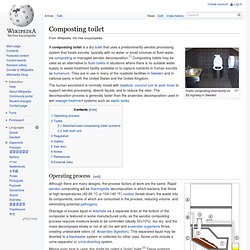
They are in use in many of the roadside facilities in Sweden and in national parks in both the United States and the United Kingdom. The human excrement is normally mixed with sawdust, coconut coir or peat moss to support aerobic processing, absorb liquids, and to reduce the odor. The decomposition process is generally faster than the anaerobic decomposition used in wet sewage treatment systems such as septic tanks. Operating process[edit] Types[edit] Manufactured composting toilet systems[edit]
Septage. In the United States, the partially treated waste store in a septic tank is called septage.[1] It generally consists of all the household wastes that are disposed of through a home's plumbing system that neither drain out into the soil nor are converted to gases by the bacteria in the tank.
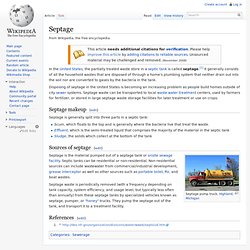
Disposing of septage in the United States is becoming an increasing problem as people build homes outside of city sewer systems. Septage waste can be transported to local waste water treatment centers, used by farmers for fertilizer, or stored in large septage waste storage facilities for later treatment or use on crops. Septage makeup[edit] Septage is generally split into three parts in a septic tank: Scum, which floats to the top and is generally where the bacteria live that treat the waste.Effluent, which is the semi-treated liquid that comprises the majority of the material in the septic tankSludge, the solids which collect at the bottom of the tank Sources of septage[edit] References[edit] Jump up ^
Portable toilet. A line of portable toilets.
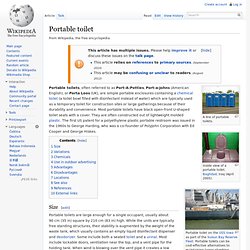
Inside view of a portable toilet. Baghdad, Iraq (April 2005). Portable toilets, often referred to as Port-A-Potties, Port-a-Johns (American English), or Porta Loos (UK), are simple portable enclosures containing a chemical toilet (a toilet bowl filled with disinfectant instead of water) which are typically used as a temporary toilet for construction sites or large gatherings because of their durability and convenience. Most portable toilets have black open-front U-shaped toilet seats with a cover.
They are often constructed out of lightweight molded plastic. Size[edit] Total Weight: 90 kg (200 lb) - 110 kg (240 lb)Total Width : 1,166 mm (45.9 in)Total Depth : 1,215 mm (47.8 in)Total Height : 2,316 mm (91.2 in)Door Height : 1,975 mm (77.8 in)Door Width : 639 mm (25.2 in) Variations[edit] Portable potty on top of a mountain in China Newer models include toilet paper and, occasionally, antibacterial hand sanitizer dispensers. 'Luxury' portable toilets also exist. Confined space. A confined space warning sign on process equipment.

Confined space accidents are of particular concern in occupational safety and health because often multiple casualties occur when untrained rescuers succumb to the same hazard as the initial victim.[1] Confined space training outlines the skills and protocols for safe entry to confined spaces, and includes such precautions as lockout and tagout of any connecting piping, testing of breathable air quality, forced ventilation, observation of workers in the space, and a predetermined rescue plan with appropriate safety harness and other rescue equipment. Description[edit] Although the definition of a confined space varies between jurisdictions, it is generally recognized as a space that: has limited or restricted means of entry or exit;is large enough for a person to enter to perform tasks;is not designed or configured for continuous occupancy;[2] andhas the potential for a significant hazard to be present.
Atmospheric hazards[edit] Public toilet. A public toilet (also called a bathroom, restroom, latrine, comfort room, powder room, toilet room, washroom, water closet, W.C., public lavatory, lav, convenience) is a room or small building containing one or more toilets and possibly also urinals which is available for use by the general public, or in a broader meaning of "public", by customers of other services.
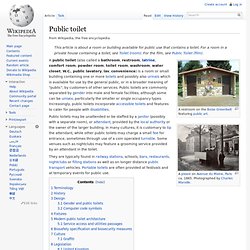
Public toilets are commonly separated by gender into male and female facilities, although some can be unisex, particularly the smaller or single occupancy types. Increasingly, public toilets incorporate accessible toilets and features to cater for people with disabilities. Portable toilet. Ballcock. When a toilet's handle is turned, a discharge mechanism is activated by means of a rod or chain.
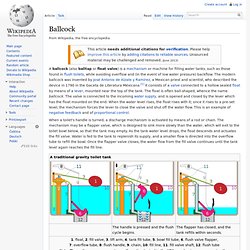
The mechanism may be a flapper valve, which is designed to sink more slowly than the water, which will exit to the toilet bowl below, so that the tank may empty. As the tank water level drops, the float descends and actuates the fill valve. Water is fed to the tank to replenish its supply, and a smaller flow is directed into the overflow tube to refill the bowl. Once the flapper valve closes, the water flow from the fill valve continues until the tank level again reaches the fill line.